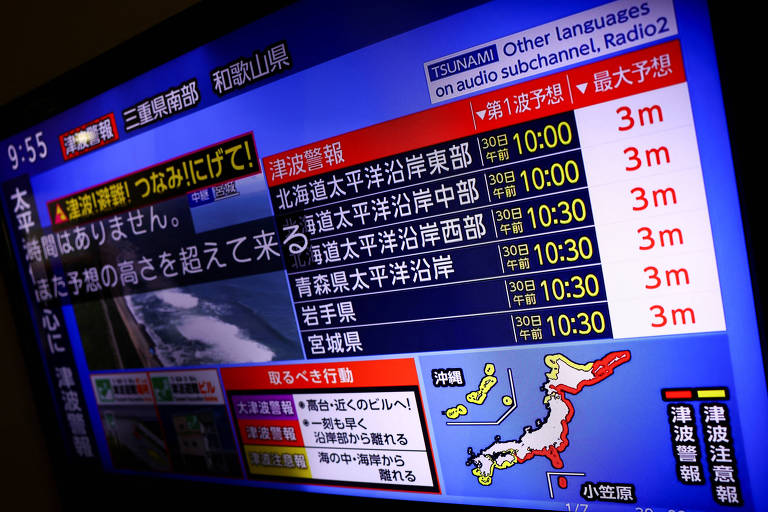Tsunami hits Japan and Russia after 8.8 magnitude earthquake

An 8.8 magnitude earthquake —the strongest in the world since the 2011 earthquake that caused the Fukushima nuclear disaster— struck the Kamchatka Peninsula in Russia on Wednesday (30), still Tuesday night in Brazil, generating a tsunami that hit Russian territory and Japan with waves of 3 to 4 meters.
Shortly after the earthquake, Russian authorities reported that, as of 10:30 p.m. (Brasília time), there were reports of people with minor injuries in the east of the country. The governments of Japan and the US state of Hawaii issued evacuation orders for coastal areas.
A Japanese official said around 11 p.m. Brasília time that no injuries had been reported in the country so far and that no nuclear power plants had reported any irregularities. Even so, workers removing radioactive waste from the former Fukushima plant were evacuated after the alert.

The U.S. Tsunami Warning System has issued warnings for "dangerous tsunami waves" along the entire U.S. West Coast, as well as Japan, Russia, Alaska, Canada , Hawaii, and Ecuador . Warnings are also in effect for Indonesia , the Philippines , Mexico , the U.S. island territory of Guam, and other Micronesian islands.
US President Donald Trump addressed the incident on his social media platform, Truth Social. "Due to a massive earthquake in the Pacific Ocean, a tsunami warning is in effect for all residents of Hawaii," the Republican wrote. "STAY STRONG AND STAY SAFE!"
The U.S. Geological Survey (USGS) reported that the earthquake was shallow, at a depth of 19.3 km, with its epicenter about 125 km east of the Russian city of Petropavlovsk-Kamchatsky. The agency had previously reported a magnitude of 8.0—a magnitude revised to 8.7 and then to 8.8 minutes later.
Just over 30 minutes after the first tremor, the American service issued a warning of another earthquake of magnitude 6.9, about 48 km away from the first and at a depth of 10 km.
Kamchatka and Russia's Far East lie on the so-called Pacific Ring of Fire, a geologically active region prone to major earthquakes and volcanic eruptions.
Images posted on social media show sirens activated in Japanese cities, warning residents of the tsunami. Some train services have been suspended in Japan. In Russia, videos show the impact of the earthquake and tsunami in the eastern region of the country.
The tremor recorded this Tuesday is the strongest in the world since the 2011 earthquake, when a magnitude 9.1 earthquake struck the Japanese archipelago and triggered a tsunami in three prefectures: Iwate, Miyagi, and Fukushima. The earthquake left more than 20,000 dead and missing, and at least 100,000 homeless.

At the time, waves of up to 45 meters flooded the Fukushima Daiichi Nuclear Power Plant, where three of the six nuclear reactors melted down after a failure of the emergency generators, releasing radioactive elements into the air, water, and land. It was the most serious nuclear accident since Chernobyl, Ukraine, in 1986.
The Russian government has ordered the complete evacuation of residents from cities in the Sakhalin region. "Today's earthquake was severe and the strongest in decades of tremors," Kamchatka Governor Vladimir Solodov said in a video posted on the Telegram app. He stated that, according to preliminary information, there were no injuries, but that a kindergarten was damaged.
Sakhalin Governor Valery Limarenko said an evacuation order had been issued for the small town of Severo-Kurilsk, which suffered flooding. About 2,000 people live there—images on social media show damage to the city's port.
uol




